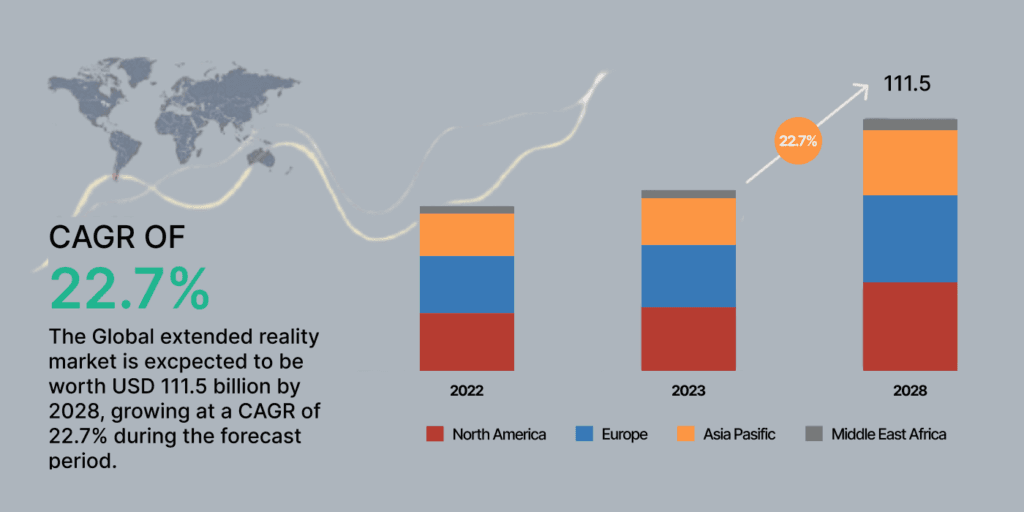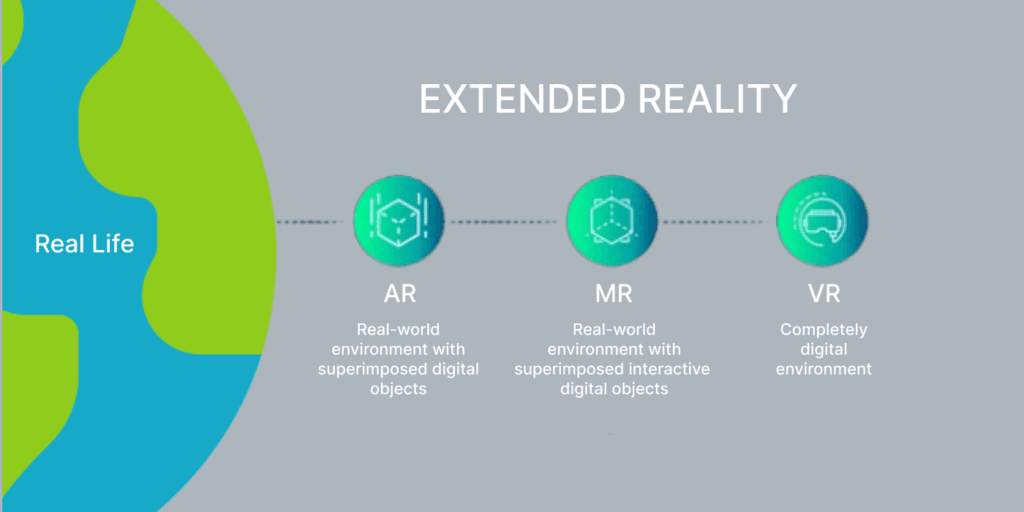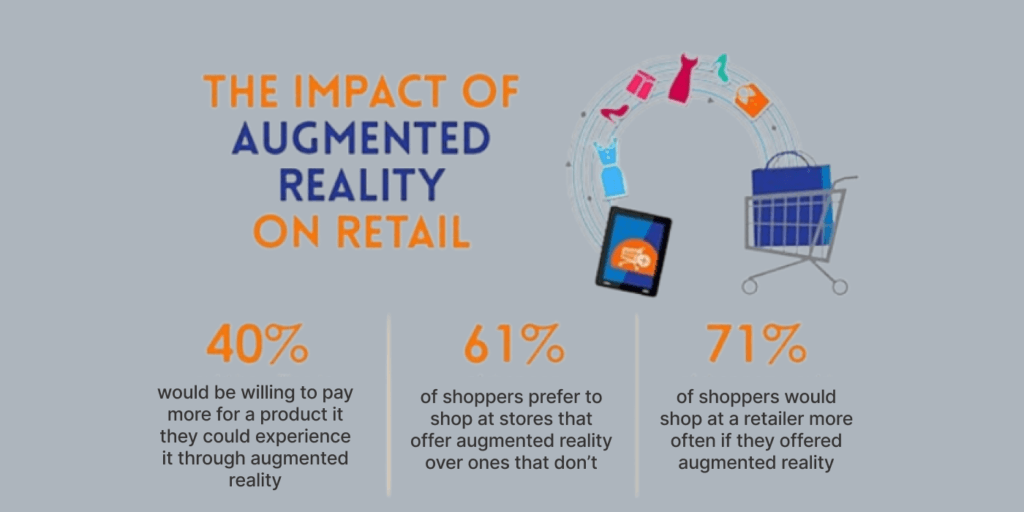Encompassing various types of immersive technology, from virtual reality (VR) to mixed reality (MR) and augmented reality (AR), extended reality (XR) is gaining so much traction nowadays. Though introduced just a few years ago, XR is already changing how people perceive and interact with the physical world. While combining the real and virtual worlds using special hardware and software, XR gives people an immersive viewing experience.
It has evolved so much, and many think it will influence how workplaces operate in the future. VR is becoming increasingly common across all products and services for consumers and businesses. You’ll find XR appearing in small ways and being the main focus of an experience. It’s present in all industries, from gaming and entertainment to education, healthcare, retail, and beyond.
According to expert predictions, extended reality will record more than 45% in the next few years. Given XR’s rising popularity, it’s essential to know the key stats, facts, and current trends in the XR industry. A basic understanding of what’s happening in the XR world can help you develop an innovative, effective XR strategy for your products or business. Let’s explore some essential insights and statistics to inform your approach and vision for using XR.
Key Extended Reality Statistics and Facts
Extended Reality Customer Engagement Statistics

1. XR provides medical professionals with exciting healthcare opportunities.
2. Experts predict improvements in XR hardware, like smaller, more comfortable devices with better software, will drive adoption across sectors like healthcare, automotive, and manufacturing.
3. In a 2020 survey, 42% said more minor, fashionable devices will help XR technology become more popular.
4. Global AR/VR spending was projected to reach $12 billion in 2020 and is expected to grow to $72.8 billion by 2024.
5. AR is used in many industries, including healthcare, public safety, tourism, marketing, and oil and gas. VR gaming and video are the most significant consumer uses of VR.
6. XR has some safety concerns, as users focused on the virtual world may bump into tangible objects and get injured.
Benefits of Extended Reality Statistics

7. In 2017, conjoined twins were successfully separated through surgery at the University of Minnesota Children’s Hospital. Surgeons used extended reality (XR) technology to visualize how the twins were connected, making the separation procedure easier.
8. A 2019 report predicted that virtual reality (VR) and augmented reality (AR) technologies will boost the worldwide gross domestic product (GDP) by $1.5 trillion by 2030, a significant increase from $46.4 billion in 2019.
9. XR technology in the medical field, like for the surgery to separate the conjoined twins, helps demonstrate XR’s potential economic impact in driving GDP growth globally over the next decade.
10. XR hardware and software advancements enable expanded use cases across industries that can significantly improve productivity and efficiency. Forecasts indicate the XR market will increase in the coming years.
Augmented Reality Growth Statistics

11. Mobile AR device usage is exploding – expected to reach 1.7 billion worldwide by 2024, up from 200 million in 2015.
12. The global AR glasses market could be worth over $883 million by 2025, growing at nearly 18% annually.
13. AR gaming is the fastest-growing segment, projected to hit $43 billion in revenue by 2028 at over 30% yearly growth.
14. Healthcare is a huge growth area for AR/VR tech, estimated to reach almost $11 billion by 2025 at over 36% annual growth.
15. B2C AR advertising revenue through AR hardware could top $6.7 billion in 2027.
16. India’s AR ad market alone may surpass $113 million in 2022.
17. Yet over half of retailers feel unprepared for emerging mobile tech like AR/VR.
18. The automotive AR market is projected to grow from $4.5 billion in 2021 to $14.4 billion by 2028.
19. 57% of innovators see navigation as the top application for future AR/VR tech.
20. Global AR hardware for consumers could reach 106 million units, generating $9.1 billion in 2027.
21. AR smart glasses display chips may be a $41 million market by 2026.
22. Consumer AR/VR headset shipments have topped 13 million units in 2022.
Extended Reality Market Trends

23. Major XR headset vendors include Sony, Oculus, and HTC for VR devices and Microsoft, Vuzix, and Magic Leap for AR headsets and glasses.
24. Qualcomm and LG are leading owners of XR patents.
25. Qualcomm partnered with 15 telecoms to create the Global XR Content Telco Alliance to develop 5G-powered AR/VR content.
26. As of 2020, the US had 841 extended reality patents registered, Japan had 687, and the World Intellectual Property Organization had 502 XR patents.
27. A 2019 report predicted that by 2024, over 23 million jobs globally will be enhanced by VR and AR technologies, up from 800,000 in 2019.
The XR industry is continuing to grow and innovate, with key players investing in the core technologies, content, and use cases that will drive further market expansion and adoption in the years ahead across commercial and consumer applications.
Augmented Reality Statistics for E-commerce

28. The global AR/VR education market was valued at $12.4 billion in 2020 and is projected to grow over 18% annually through 2027.
29. In 2020, consumer utility products accounted for over half (52.9%) of AR/VR spending worldwide.
30. Revenue from augmented reality glasses for consumers and enterprises will hit $1.85 billion in 2021 and soar to $35 billion by 2026.
31. Gen Z consumers are most interested in AR shopping experiences like virtual try-ons and room visualizations.
32. Thanks to their agility, small and medium businesses dominated India’s AR market in 2020 with a 62.92% share.
33. Virtual and augmented reality will generate 23 million jobs worldwide across industries by 2030, up from 800,000 jobs in 2019.
34. The global AR/VR market could be worth $80 billion by 2025.
Training Statistics on Augmented Reality

35. The adoption of VR/AR for employee training is rapidly increasing, with 26% of businesses using it in 2020 and 70% of professionals expecting organizations to focus on it more in 2021.
36. VR training has proven benefits, like reducing workplace injuries by 43% and achieving a 75% retention rate compared to only 5-20% for lectures, reading, and audio-visual methods.
37. 68% believe AR/VR training simulations will be the primary focus in healthcare through 2022.
38. And 39% of large organizations already leverage VR/AR to facilitate training in simulated environments.
39. Police officers receiving virtual training are 2.7x more likely to have successful missions.
40. Significant companies are leading the way. DHL Express collaborated to build a VR platform, and 90% of participants said it improved efficiency.
41. Intel found that 94% of trainees wanted more VR courses, projecting a 5-year ROI of 300% for a single course. Boeing cut training time by 75% with VR.
42. A restaurant chain increased certified trainees from 50% to 77% within a month using VR onboarding.
Statistics of Retail Augmented Reality

43. Retail is projected to see the most significant commercial investment in AR/VR tech at $7.3 billion by 2024.
44. 61% of customers prefer online shops offering AR experiences.
45. 40% would spend more on AR-customizable products.
46. 70% would be more loyal to brands with AR experiences.
47. VR virtual stores could reduce home try-ons in apparel by 25%.
48. Online virtual fitting rooms can improve conversion by 6.4%, order value by 1.6%, and reduce fulfillment costs by 5% and returns by 5.2%.
49. 53% of consumers feel retailers are not taking enough advantage of AR.
50. A cosmetics brand increased click-through by 53%, sales by 28 points, and brand awareness by 7.9 points with an AR Facebook filter.
51. During COVID-19, retailers using AR saw 19% higher engagement and 90% higher conversions.
52. Product pages with AR/3D drove 13% larger orders and 21% higher revenue per visit.
Facts about Augmented Reality

53. Augmented reality has been around for quite a while—it first appeared in 1968 when Ivan Sutherland, a computer scientist, created the first headset system at Harvard to display simple graphics and wireframe drawings.
54. The term “augmented reality” wasn’t in existence until 1990 by Boeing engineers Tom Caudell and David Mizell as they worked on using AR headsets to guide aircraft manufacturing.
55. One of the earliest examples of AR in marketing was BMW’s MINI campaign, which showed a virtual car model in a print ad by holding it up to a webcam.
56. The auto industry has embraced AR for safety training and workforce guidance. Experts predict that up to 75% of vehicles will be automated by 2040.
57. Studies show that about half of 18-—to 34-year-olds are familiar with AR tech. Today’s most significant AR products, like Google Maps with AR navigation features, reach over a billion users monthly.
58. AR gaming has also taken off significantly, with Pokemon Go’s location-based AR gameplay generating over $4.5 billion in revenue since 2016.
59. Apple’s ARKit tools have also led to over 13 million downloads of AR-enhanced apps.
The possibilities for creative and valuable AR experiences keep expanding across industries. It’s exciting to think about where AR could go next!
Conclusion
The extended reality industry is rapidly expanding across consumer and enterprise domains. AR usage on mobile devices alone could reach 1.7 billion users worldwide by 2024. Key growth areas include gaming ($43B by 2028), healthcare ($10.8B by 2025), advertising ($6.7B by 2027), education ($12.4B in 2020), and the automotive sector ($14.4B by 2028).
Emerging trends point to AR smart glasses going mainstream, enhanced product visualization and navigation, increasingly sophisticated AR training simulations, location-based entertainment experiences, and integration with 5G networks and edge computing.
As user familiarity and comfort with XR technology rises, new creative applications will continue to drive market expansion. The global AR market could be worth $80 billion within a few years. XR capabilities across B2C and enterprise environments transform how people perceive, interact with, and extract value from the blended physical-digital world. The future looks immensely augmented indeed.
Frequently Asked Questions
The extended reality market worldwide reached $42.86 billion in 2021, and its CAGR is expected to increase by 57.91% over the next few years until 2027.
AR overlays digital content in the real world through smartphones, tablets, and smart glasses. The global AR market is projected to reach $80 billion by 2025.
AR enhances reality, while VR creates an entirely virtual environment. Unlike VR’s immersive simulation, AR lets you see the real world plus virtual objects. The AR/VR education market was $12.4 billion in 2020.
Any device with a camera, display, sensors, and processing power can enable AR experiences – including phones, tablets, glasses, and headsets. Mobile AR device usage is expected to hit 1.7 billion worldwide by 2025.
AR has retail, manufacturing, education, entertainment, healthcare, automotive, and more applications. In 2020, consumer utility products accounted for 52.9% of global AR/VR spending.
AR increases contextual information, enables immersive visualization, facilitates hands-free interaction, improves training effectiveness (36% CAGR in healthcare), connects physical and digital worlds, and creates new entertainment avenues. The AR gaming market could reach $43 billion by 2028.
AR experiences are built using specialized software development kits (SDKs) like ARKit and ARCore to implement AR capabilities in mobile apps and websites. Consumer/enterprise AR glasses revenue may exceed $35 billion by 2026.
Projected trends include AR smart glasses becoming mainstream, enhanced AR navigation and product discovery, increasingly advanced AR training tools, location-based AR entertainment, AR integrating with 5G and edge computing, and new innovative use cases across domains.
